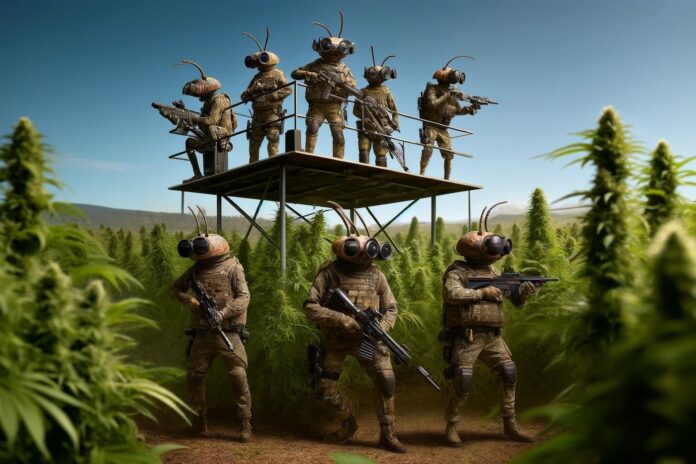Any gardener can tell you ladybugs are nice beneficial pests. While having a healthy coccinellidae population is hardly a bad thing, it’s far from an effective pest management strategy in a commercial setting. In fact, ladybugs are known to “farm” aphids, making sure to stockpile their favorite sap-sucking insects so they have a constant supply of food. On the other hand, serious predator bugs like aphidius colemani, a parasitic wasp, can decimate aphid colonies in greenhouses and commercial fields. These beneficial bugs lay eggs in aphid nymphs and let their larvae consume any problematic pests from the inside.
Just like the bugs themselves, insect and pest management programs can eat into profits. While cultivation facilities should always consider chemical and biological pest control when developing operating procedures to help reduce the chance of infestations, determining the most cost-effective method between these modes of action is an ongoing challenge. Using scouting techniques to monitor pest populations provides critical information on the appropriate action to prevent and cure pest infestations.
Generalist or predator?
Always use serious predators to target serious pest problems instead of relying on lazy generalists like ladybugs. Identify your pest and hire their best enemy to eliminate them.

- Deploy Amblyseius andersoni for two-spotted spider mites (TSSM) and thrip control, especially when dealing with TSSM. Andersoni are reliable generalist predators, meaning they feed on more than one species. However, as generalists, they are less aggressive than more specialized predators.
- Deploy Amblyseius swirskii for TSSM and thrip control, especially when dealing with thrip infestations. Swirskii are more specialized than andersoni. While swirskii actively hunt and eat soft-bodied pests like thrips, they only feed on the spider mites’ larvae and eggs.
- Deploy Amblyseius californicus for TSSM. Californicus are specialists for TSSM but do not have a habit of eating thrips.
- Deploy Phytoseiulus persimilis for TSSM. Persimilis are the ultimate predators for controlling TSSM because they’ve co-evolved with these non-insect pests, staying ahead of the biological arms race.
- Deploy Aphidius ervi for control over cannabis aphids. In less than one second, this vigorous parasite examines an aphid, determines if it’s been parasitized, and stabs it with its ovipositor to lay eggs if it’s a suitable host to feed its young.
- Deploy Aphidius colemani for control over green peach aphids or greenflies. These slender, dark parasitic wasps work just like their ervi counterparts and often hunt smaller insects.
- Deploy Chrysoperla species (green lacewings) for knocking down clusters of aphids that develop on the stems and underside of fan leaves. The larvae of these delicate green bugs are small, fast, and aggressive predators capable of eating about 100 aphids over their lifespan.
“When building a cannabis crop protection program, I typically focus on biological control agents (BCAs) for control over pests such as two-spotted spider mites, aphids, thrips, and certain kinds of caterpillars, said Daniel Graham-Boire, cannabis technical advisor at BFG Supply Co. “For diseases, we rely on a group of bio-rational pesticides that either block infection or actively fight against pathogenic agents. By utilizing a combination of BCA and bio-rational tools, we can safely and effectively control pests and diseases in cannabis production.”
Cost and application of predator insects
The cost of biological predators varies greatly due to shipping and supply limitations. Generally, it costs between $50 and $100 for enough insects to cover about 1,000 square feet of application area. Most predatory insects are available for purchase in their adult and egg or larval form.
When purchased in adult form, controls are delivered in packets or sachets with a limited food source. These small bags are designed to hang the canopy or rest on top of grow media. As soon as they are added to the garden, the predators immediately leave the sachet or packet to hunt for a new food source.
When purchased in egg or larvae form, the insects arrive in small biodegradable egg structures. They can be placed directly on top of the growing media, where the eggs will hatch and go to work. It is important to have an adequate environment for the eggs and larvae—maintaining a temperature of 75 degrees and humidity of 50 percent works well for most biological controls.
Insects should be applied every two to three weeks throughout the grow cycle. Beneficial bugs can be applied in any stage of growth. Assuming a twelve-week grow cycle, cultivators can expect to spend around $200 to $400 purchasing biological controls for a 1,000-square-foot grow. In addition to the cost of bugs, cultivators should plan for one to two hours of labor for each deployment.
Cost of spraying
Horticulture oils, biological agents, and synthesized chemicals each require different applicators for spraying. As a result, operators need to consider the cost of tools, maintenance, and storage. Worker training for spraying is another critical component to ensure pesticides are mixed at the correct application rates while adhering to strict worker safety guidelines.
Some pesticides, such as PyGanic and Venerate, have a re-entry interval to consider. After these chemicals are sprayed, staff members without protective clothing and equipment must stay out of the area until the interval time has passed. In many instances, these restrictions lead to significant scheduling issues at cultivation facilities of all sizes.
Pesticide concentrates range from $50 to $200 for a quart to a gallon depending on brand and ingredients, and application rates can vary greatly depending on the severity of infection and the targeted pest. Cultivators should expect to spend about $1 to $10 for enough concentrate to cover a 1,000-square-foot space. The associated labor will be about two to four hours per application. In an ideal setting, pest prevention applications should happen once or twice weekly, stopping after the second or third week of flowering. For a twelve-week growth cycle, between seven and fourteen applications would be required, necessitating 14 to 56 hours of labor.
Multiple modes of action
Attacking an infestation often requires pesticides and beneficial insects. Pesticides can provide knockdown power, eliminating numerous pests in one sweep. After the pest population has been reduced, beneficial bugs can be introduced to help eliminate the remaining targeted pest colony.
Further rounds of pest application may be required to help knock down the colony. When pesticides are used in conjunction with beneficial bugs, care must be taken to monitor the populations of all bugs to avoid friendly fire. Pesticides do not discriminate between good bugs and bad bugs, leaving operators to handle this responsibility.
Growers should use sticky traps and maintain detailed logs on pest populations to understand which bugs are causing problems in the garden over time. Having a dedicated employee scout monitoring these traps and logs is crucial for data gathering. With the right data, cultivation facilities can develop a complete picture of the pests they’re battling and prepare for future mitigation and prevention.
Plan for pests and pest control
Cultivators must take regular and honest assessments of the costs and benefits of traditional pesticides and biological controls when building standard operating producers for insect and pest management programs. Even with the best policies in place, determining the most cost-effective mode of action and the best timing for every situation takes a great deal of experience. Savvy cultivators can begin to close experience gaps with reliable historical data and employee training for scouting pests and monitoring traps. Eliminating wasted resources on supplies and labor starts with gathering data about pests and using the information to make the most informed decision possible.










